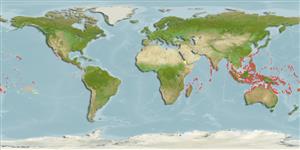>
Ovalentaria/misc (Various families in series Ovalentaria) >
Pomacentridae (Damselfishes) > Pomacentrinae
Etymology: Pomacentrus: Greek, poma, -atos = cover, operculum + Greek, kentron = sting (Ref. 45335).
More on authors: Evermann & Seale.
Environment: milieu / climate zone / depth range / distribution range
Ekologi
laut berasosiasi dengan karang; nir-ruaya; kisaran kedalaman 1 - 20 m (Ref. 7247). Tropical; 30°N - 23°S
Indo-West Pacific: Maldives to Rowley Shoals, New Caledonia,and north to the Ryukyu Islands.
Size / Weight / umur
Maturity: Lm ? range ? - ? cm
Max length : 10.0 cm FL jantan/; (Ref. 5525)
duri punggung lunak (Keseluruhan (total)): 13-15; Sirip dubur lunak: 14 - 15; vertebrata, bertulang belakang: 22 - 24. This species is distinguished by the following characters: an orange hue on the thorax and ventralmost part of the sides, and juveniles have an expanded yellow-to-orange zone posteriorly on the body, encompassing the soft dorsal and anal fins, caudal fin, and adjacent caudal peduncle (Ref. 114927).
Adults occur in lagoons, steep-sided channels, and seaward reefs from 2 to over 12 m (Ref. 1602). Usually found in groups off the sides of vertical drop-offs and overhanging ledges (Ref. 1602). Oviparous, distinct pairing during breeding (Ref. 205). Eggs are demersal and adhere to the substrate (Ref. 205). Males guard and aerate the eggs (Ref. 205). Diurnal species (Ref. 54980; 113699). Maximum depth reported taken from Ref. 128797.
Life cycle and mating behavior
Kematangan | Reproduksi, perkembang biakan | Pemijahan | telur-telur | Fecundity | Larva
Oviparous, distinct pairing during breeding (Ref. 205). Eggs are demersal and adhere to the substrate (Ref. 205). Males guard and aerate the eggs (Ref. 205).
Allen, G.R., M.V. Erdmann and P.D. Pertiwi, 2017. Descriptions of four new species of damselfishes (Pomacentridae) in the Pomacentrus philippinus complex from the tropical western Pacific Ocean. J. Ocean Sci. Found. 25:47-76. (Ref. 114927)
Status IUCN Red List (Ref. 130435)
ancaman kepada manusia
Harmless
penggunaan manusia
Akuarium: Komersial
informasi lanjut
AcuanBudidaya airprofil budidaya airStrainGenetikaElectrophoresesDiturunkanPenyakit-penyakitPengolahanNutrientsMass conversion
Alat, peralatan
laporan khas
muat turun XML
Sumber internet
Estimates based on models
Preferred temperature (Ref.
123201): 25.3 - 29.3, mean 28.4 °C (based on 2636 cells).
Phylogenetic diversity index (Ref.
82804): PD
50 = 0.5000 [Uniqueness, from 0.5 = low to 2.0 = high].
Bayesian length-weight: a=0.01778 (0.00993 - 0.03183), b=2.98 (2.82 - 3.14), in cm total length, based on LWR estimates for this species & (Sub)family-body (Ref.
93245).
Trophic level (Ref.
69278): 2.7 ±0.29 se; based on food items.
Daya lenting (Ref.
120179): Tinggi, Waktu penggandaan populasi minimum kurang dari 15 bulan (Preliminary K or Fecundity.).
Fishing Vulnerability (Ref.
59153): Low vulnerability (10 of 100).
Nutrients (Ref.
124155): Calcium = 126 [70, 212] mg/100g; Iron = 0.834 [0.517, 1.318] mg/100g; Protein = 18.6 [17.6, 19.6] %; Omega3 = 0.138 [0.086, 0.220] g/100g; Selenium = 18.8 [10.9, 33.9] μg/100g; VitaminA = 144 [49, 433] μg/100g; Zinc = 2.2 [1.5, 3.0] mg/100g (wet weight);
